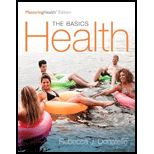
Health: The Basics, The Mastering Health Edition (12th Edition)
12th Edition
ISBN: 9780134183268
Author: Rebecca J. Donatelle
Publisher: PEARSON
expand_more
expand_more
format_list_bulleted
Question
Chapter 1, Problem 3PQ
Summary Introduction
To determine: The term used to describe tasks like tying shoe lace and walking in stairs.
Introduction:
Everyday tasks are the activities performed by an individual day in and day out. This helps an individual fulfil his basic needs, to commute, and to live his/her life completely in a healthy manner.
Expert Solution & Answer
Want to see the full answer?
Check out a sample textbook solution
Chapter 1 Solutions
Health: The Basics, The Mastering Health Edition (12th Edition)
Ch. 1 - Prob. 1WDYTCh. 1 - Prob. 2WDYTCh. 1 - Prob. 3WDYTCh. 1 - Prob. 4WDYTCh. 1 - Prob. 5WDYTCh. 1 - Prob. 6WDYTCh. 1 - Prob. 7WDYTCh. 1 - Prob. 8WDYTCh. 1 - Prob. 9WDYTCh. 1 - Prob. 1PQ
Ch. 1 - What statistic is used to describe the number of...Ch. 1 - Prob. 3PQCh. 1 - Janice describes herself as confident and...Ch. 1 - Healthy People 2020 is a(n) a. blueprint for...Ch. 1 - Prob. 6PQCh. 1 - Suppose you want to lose 20 pounds. To reach your...Ch. 1 - Prob. 8PQCh. 1 - Prob. 9PQCh. 1 - Prob. 10PQCh. 1 - Prob. 1TAICh. 1 - Prob. 2TAICh. 1 - What are some of the health disparities that exist...Ch. 1 - Prob. 4TAICh. 1 - Prob. 5TAICh. 1 - Prob. 1PQACh. 1 - Prob. 2PQACh. 1 - Prob. 3PQA
Knowledge Booster
Recommended textbooks for you
 Comprehensive Medical Assisting: Administrative a...NursingISBN:9781305964792Author:Wilburta Q. Lindh, Carol D. Tamparo, Barbara M. Dahl, Julie Morris, Cindy CorreaPublisher:Cengage Learning
Comprehensive Medical Assisting: Administrative a...NursingISBN:9781305964792Author:Wilburta Q. Lindh, Carol D. Tamparo, Barbara M. Dahl, Julie Morris, Cindy CorreaPublisher:Cengage Learning- Lifetime Physical Fitness & WellnessHealth & NutritionISBN:9781337677509Author:HOEGERPublisher:Cengage

Comprehensive Medical Assisting: Administrative a...
Nursing
ISBN:9781305964792
Author:Wilburta Q. Lindh, Carol D. Tamparo, Barbara M. Dahl, Julie Morris, Cindy Correa
Publisher:Cengage Learning




Lifetime Physical Fitness & Wellness
Health & Nutrition
ISBN:9781337677509
Author:HOEGER
Publisher:Cengage
